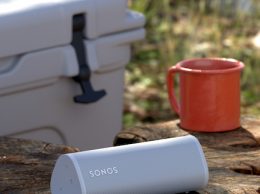
A still from one of Sonos’ new TV spots, in which a home is lacquered in gold as one of its speakers streams Isaac Hayes’ theme from “Shaft.”
Sonos has taken its technology truly wireless as it expands its on-demand music listening capabilities.
The consumer audio gear maker is a South Coast behemoth, with $535 million in 2013 revenue and 400 employees sprawled across 100,000-square-feet at its downtown Santa Barbara headquarters. Its property holdings make it the largest private-sector tenant in one of the nation’s most coveted commercial markets.
Last month, Sonos released a major software update enabling its speakers to connect to WiFi directly; before, users who wanted to tap its streaming services had to set up a wired connection between a router and one of the system’s speakers or a secondary component, the $50 Sonos Bridge.
The company’s flurry of developments continued Oct. 14 with the release of a product called Boost, a WiFi amplifier that surpasses the Bridge’s capabilities without the need for wires. The $100 component promises to bring commercial-grade stability and range to household wireless networks, giving Sonos a possible route to expand into the Internet of Things.
To distinguish its offerings going forward, the company may have to build on the Boost’s appeal as a multi-purpose signal strengthener across technologies. A national television ad campaign launched Oct. 12 combines buoyant pop-art animation with mesmerizing tunes, encouraging viewers to “Sonos your home.” Some of the first ads aired in conjunction with the NFL football broadcast on CBS.
More immediately, however, the product aims to banish buffering and uphold high sound quality as the company continues to build the roster of streaming services paired with its speakers. Although Sonos systems have long incorporated on-demand music services such as Spotify, Rdio and Soundcloud, the company’s latest deal with French music subscription firm Deezer is a move to capture the most discerning audio streamers.
According to company representative Eric Nielsen, Sonos was an early adopter of such services because it “saw the ability to play all the music on earth in any room as the future of listening in the home.”
Deezer entered the U.S. market last month with Deezer Elite, a music subscription plan available exclusively through Sonos products. The service, which costs around $120 a year, includes access to a library of 35 million tunes delivered in an audio format called FLAC, known for providing extremely crisp sound quality in an efficient package. According to Deezer, FLAC files deliver fives times as much sonic information as MP3s.
Russ Crupnick, an analyst at MusicWatch, said the Deezer Elite service is likely to be taken up by audiophiles heretofore frustrated with the poor sound quality most streaming services relay over their expensive, high-fidelity speaker system. “The more highly engaged music fan is going to find it first,” Crupnick said, and those who value a high-end listening experience tend to be Sonos’ most loyal customers.
So far, more than 50 streaming services are available through Sonos speakers. Twenty of those were added in the last year. “We expect there will be hundreds more and we hope to have all of them,” Nielsen said.
Sonos doesn’t release data on sales of its products or rates of streaming use, but Nielsen did say on-demand service subscribers form the core of its client base. “Our customer is listening to music digitally and wanting a better way listen at home,” he said.
Additionally, Nielsen said Sonos splits its sales 50-50 between the U.S. and the rest of the world, with its largest base of non-U.S. customers in Europe.
According to the International Federation of the Phonographic Industry, a global nonprofit that represents the recording industry’s interests, services such as Deezer “are seeing healthy growth in sales among a largely higher income, credit card-owning demographic, complementing ad-supported services that are free-to-consumer.” So far, the company counts 5 million paying subscribers.
Sonos’ competitors have caught on to the market for high-end music streaming. Three weeks after the ink had dried on its deal with Deezer, Bose signed a copycat agreement to offer the French company’s Premium+ music subscription, the service a tier down from Deezer Elite. And in the hardware developments, Sonos’ virtual monopoly of the multi-room audio market is at risk as Samsung and LG continue releasing products to elbow their way in.
“We love that more energy is coming into the home audio and wireless speaker space and that more and more customers are rediscovering the joys of listening to music in the home,” Sonos’ Nielsen said. “We like our head start and we’ll hopefully be leading the industry in even more innovative directions.”
Which is where the Boost comes in. “As a consumer, I know you often have trouble streaming things even if you have a higher-speed internet service,” Crupnick said. Walking around the house to search for bandwidth with a laptop can be tedious, but poor connectivity defeats the purpose of a wireless speaker system.
The company was also issued the trademark for a product called Playbase on Aug. 6, but its details remain shrouded in mystery.
And while the jury’s still out on the potential market share of streaming services, Crupnick said one certainty is the continuing decline of CD sales — digital or otherwise — at a fairly rapid rate, yielding traction to more disruptive methods of music delivery. While forgoing a CD purchase once incentivized music listeners to simply obtain songs illegally, streaming has become an easier — and thus more widespread — alternative to pirating.
“In a sense, streaming is very mainstream,” Crupnick said, pointing to Pandora’s broad demographic appeal and Youtube, which the younger generation uses to access music on-demand. “If you look at the Pandora user, they look very much like the population as a whole. You’ve got more people who are streaming than are buying CDs.”
A version of this article appeared on page 1A of the Oct. 17-23 edition of the Business Times.






 Print
Print Email
Email

















